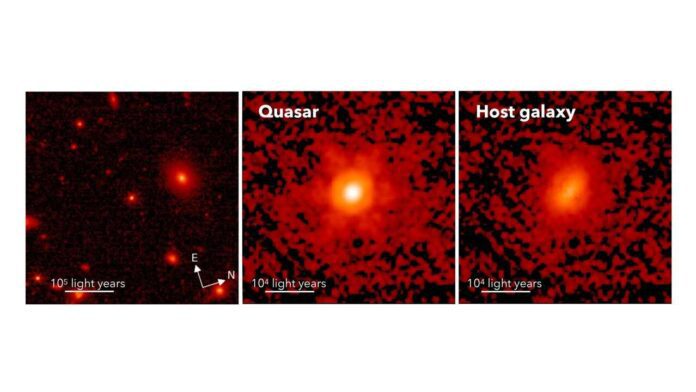New images from the James Webb Space Telescope (JWST) have revealed, for the first time, starlight from two massive galaxies hosting actively growing black holes—quasars—seen less than a billion years after the Big Bang. A new study in Nature finds the black holes have masses close to a billion times that of the sun, and the host galaxy masses are almost one hundred times larger, a ratio similar to what is found in the more recent universe. A powerful combination of the Subaru Telescope and the JWST has paved a new path to study the distant universe.
The existence of such massive black holes in the distant universe has created more questions than answers for astrophysicists. How could these black holes grow to be so large when the universe was so young? Even more puzzling, observations in the local universe show a clear relation between the mass of supermassive black holes and the much larger galaxies in which they reside. The galaxies and the black holes have completely different sizes, so which came first: the black holes or the galaxies? This is a “chicken-or-egg” problem on a cosmic scale.
An international team of researchers, led by Kavli Institute for the Physics and Mathematics of the Universe (Kavli IPMU) Project Researcher Xuheng Ding and Professor John Silverman, and Peking University Kavli Institute for Astronomy and Astrophysics (PKU-KIAA) Kavli Astrophysics Fellow Masafusa Onoue have started to answer this question with the JWST, launched in December 2021. Studying the relation between host galaxies and black holes in the early universe allows scientists to watch their formation, and see how they are related to one another.
Quasars are luminous, while their host galaxies are faint, which has made it challenging for researchers to detect the dim light of the galaxy in the glare of the quasar, especially at great distances. Before the JWST, the Hubble Space Telescope was able to detect host galaxies of luminous quasars when the universe was just under 3 billion years old, but no younger.
The superb sensitivity and the ultra-sharp images of the JWST at infrared wavelengths finally allowed researchers to push these studies to the time when the quasars and galaxies first formed. Just a few months after JWST started regular operations, the team observed two quasars, HSC J2236+0032 and HSC J2255+0251, at redshifts 6.40 and 6.34 when the universe was approximately 860 million years old.
These two quasars were discovered in a deep survey program of the 8.2m-Subaru Telescope on the summit of Maunakea in Hawai’i. The relatively low luminosities of these quasars made them prime targets for measurement of the host galaxy properties, and the successful detection of the hosts represents the earliest epoch to date at which starlight has been detected in a quasar.
The images of the two quasars were taken at infrared wavelengths of 3.56 and 1.50 micron with JWST’s NIRCam instrument, and the host galaxies became apparent after carefully modeling and subtracting glare from the accreting black holes. The stellar signature of the host galaxy was also seen in a spectrum taken by JWST’s NIRSPEC for J2236+0032, further supporting the detection of the host galaxy.
Analyses of the host galaxy photometry found that these two quasar host galaxies are massive, measuring 130 and 34 billion times the mass of the sun, respectively. Measuring the speed of the turbulent gas in the vicinity of the quasars from the NIRSPEC spectra suggests that the black holes that power them are also massive, measuring 1.4 and 0.2 billion times the mass of the sun. The ratio of the black hole mass to host galaxy mass is similar to those of galaxies in the more recent past, suggesting that the relationship between black holes and their hosts was already in place 860 million years after the Big Bang.
Ding, Silverman, Onoue and their colleagues will continue this study with a larger sample using scheduled Cycle 1 JWST observations, which will then further constrain models for the coevolution of black holes and their host galaxies. The team recently learned that they have been awarded additional time for JWST in its next cycle to study the host galaxy of J2236+0032 in much more detail.
Reference:
Ding, X., Onoue, M., Silverman, J.D. et al. Detection of stellar light from quasar host galaxies at redshifts above 6. Nature (2023). DOI: 10.1038/s41586-023-06345-5

[…] of stellar light from quasar host galaxies at redshifts above 6“ nebst Press Releases hier, hier und hier, „Langmuir waves associated with magnetic holes in the solar wind“ und […]
Simply wish to say your article is as astonishing. The clarity in your post is simply great, and I could assume you are an expert on this subject. Well with your permission let me grab your RSS feed to keep updated with forthcoming post. Thanks a million and please keep up the gratifying work.
I’m experiencing some small security issues with my latest blog, and I’d like to find something safer. Do you have any suggestions?